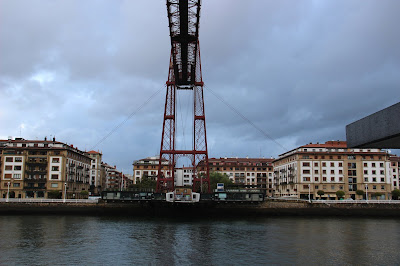The Vizcaya Bridge
Today we left early for our visit to the final transporter bridge of our trip, the Vizcaya bridge in Bilbao. It was pouring with rain and only 14 degrees when we set off, but it did not dampen our spirits as we turned a corner in Portugalete ans saw the bridge right in front of us.
The
Vizcaya Bridge known as the Bizkaiko Zubia in Basque, and Puente de Vizcaya in
Spanish,is a transporter bridge that links the towns of Portugalete and Getxo as
it crosses the mouth of the Nervion River.
People living in the area, know it as the Puente Colgante which
literally means "hanging bridge", which is used for suspension bridge
in Spanish, although it is most definitely not a suspension bridge.
The
Vizcaya Bridge was built to connect the two banks which are situated at the
mouth of the Nervion River. It is the world's oldest transporter bridge and was
built in 1893, designed by Alberto Palacio, one of Gustave Eiffel's disciples.
The Engineer Ferdinand Joseph Arnodin, who also built the bridges in Rochefort
and Newport was in charge, and the main financier of the project was Santos
Lopez de Letona. It was the solution given by the engineer to the problem of
connecting the towns of Portugalete and Getxo without disrupting the maritime
traffic of the Port of Bilbao and without having to build a massive structure
with long ramps. Palacio wanted to design a bridge which could transport
passengers and cargo, and that could allow ships to go through.
On
July 13, 2006, the Vizcaya Bridge was declared a World Heritage Site by UNESCO.
In Spain, it is the only monument in the Industrial Heritage category. UNESCO
considers the bridge to be a perfect combination of beauty and functionality.
It was the first to use a combination of iron technology and new steel cables
which began a new form of constructing bridges which was later imitated
throughout the world.
The
bridge, still in use, is 164 meters long, and its (modern) gondola can
transport six cars and several dozen passengers across the river in one and a
half minutes.
It
operates every 8 minutes during the day (every hour at night), all year round,
with different fares for day and night services, and is integrated into
Bilbao's ticket system. An estimated four million passengers and half a million
vehicles use the bridge annually.
There
are two new visitor lifts installed in the 50-metre-high pillars of the bridge
that allow walking over the bridge's platform, from where there is a view of
the port and the Abra bay.
The
structure is 45 metres high and 160 metres long. In the final design they
decided to use two horizontal girders to support the rails, and these are
supported by four pillars which stand on four towers which are situated on the
river banks. It is made of iron. Much iron was extracted from the mines of
Vizcaya, which increased the mining and shipping industry. Therefore, the
Vizcaya Bridge also represents the growth and triumph of a new era.
We crossed the river in the gondola, in our car, and parked up on the the Getxo side of the river and then made our way to the visitor centre to get our tickets to walk across the top of the bridge. Here we met the charming lady named Vanesa who running the visitor centre and when she knew where we were from she insisted on giving us 'co-worker' discounts and then having a photograph taken with us.
 |
| Vanesa |
We then took the lift to the top and we had the company of another charming lady, this time from Puerto Rica whose name was Printzel. She was scared of heights but was determined to do it. When we got to the top it poured down on us and showered us with hailstones. We persevered though and still managed to get some great shots.
 |
| Printzel Dry |
 |
| Printzel Wet |
After descending from the top we said our goodbyes to Vanesa and Printzel and returned to our hotel to change into dry clothes, before going for lunch to Baskian.
After lunch we spent a couple of hours in the Guggenheim museum and met these interesting characters on the way in.
It was a really interesting building, but I struggled a great deal with the exhibits within. On the way out we saw this unusual double act performing in the grounds outside.
















No comments:
Post a Comment